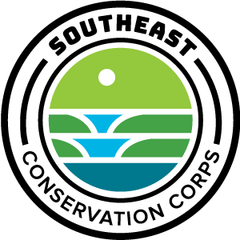Week 2 on the Yellow Trail
BlogTrail maintenance is one of the many professions done that the general public seldom fully understands the value of. It is an integral part of good trail work that the hiker, biker, horseback rider, etc., does not typically notice the work done on the path in order to provide an enjoyable recreational experience. Sometimes, however, a trail may need a bit of extra help in order for it to be hikeable, so much help that that work done by conservationists becomes rather obvious to recreationists.
My first project with the Women’s Youth Crew of the Southeast Conservation Corps was located in the Chickamauga Battlefield national park. In the previous year a tornado made its way through the area, pulling a fair amount of trees out of the ground and flooding many areas around the park quite a lot. A previous Southeast Conservation Corps crew had worked on Yellow Trail in the previous year, installing bog bridges where flooding was particularly bad.
This was done in order to prevent hikers from straying from the normal path of the trail, as when the corridor -which is the width and height of the designated trail- flooded, hikers would trek around the wet ground, therefore widening the corridor and therefore creating more areas that would be easily flooded as plant life in those spots died.
But because of the tornado in the previous year, Yellow Trail flooded an amount that was unprecedented for that particular area. This flooding was so extensive that it pulled the rebarred-down bog bridges from the wet ground. The segmented parts of the bridge floated overtop of each other and some completely off of the trail.
This is what our Women’s Youth Crew was sent in to fix. We hiked down the path with a plethora of tools in hand in order to assess the damage to the trail with our park manager, Donny. The trail was pretty much unpassable without climbing over the flipped and layered bridges. It was obvious that the people who attempted to cross the trail anyways had already carved out the edges of the trail by passing around the bridges rather than climbing. With a little bit of instruction, we set down our tools and within the next day started to work.
Our first task was to move the bog bridge segments out of our path, in order to get a good look and angle on the holes where the bridge had sat before. We pushed them out of the way with rock bars and trimmed down the corridor in order to make room for our work space. Once we could see the holes the bridge sat in we began to measure the sills that propped the slats on the top of the bridge up and dug out our holes to fit that measurement.

Next, with a little bit of trial and error, we decided to pull the bridge apart and set the segments in one at a time. Trial and error took up most of our time, testing and retesting the holes we dug in order to make sure we had the perfect height and angle for the bridge to go in at.
Once we had the sills in, we reinstalled the slat boards on top and put in crush, ground gravel, around the extra space in the holes we dug. We then rebarred in the bridge segments, this time at an angle in order to prevent a repeat of their previous upheaval.
In all, this fix took close to two weeks of Monday through Friday non-stop work, pretty much all of it done by hand. The final result was very rewarding, not only to look at but to be able to walk, run, and jump over.
This project was a bit of a unique experience in the realm of trail work, because we were able to actually look upon our final product and know that the people that used this bridge would be able to see and appreciate it too. The bridge fit together like a jigsaw puzzle that had one last piece missing from the middle and I feel safe in saying that the last piece always feels the best to put down.

There is no guarantee that a freak flood like what happened last year will not rush through that area again, but I do feel safe in saying that the areas of the bridge we worked on will be significantly more likely to withstand that flooding much longer than it had previously been able to.
Our bridge is a mark of success, not just by my Women’s Youth Crew, but by the previous adult crew that had worked on it the year before. It is a massive piece of proof not only that SECC had been there, but that they had significantly improved the trail from where it had been before we’d come along.
-Ruthie Beeland; Women's Conservation Crew




